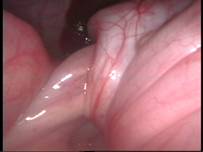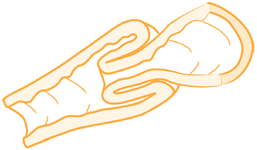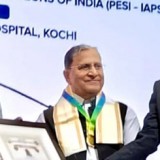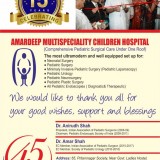INFORMATION AVAILABLE IN ENGLISH, GUJARATI AND HINDI
What is intussusception?
Intussusception is a condition where the bowel ‘telescopes’ in on itself. This causes the bowel walls to press on one another, blocking the bowel. This can lead to reduced blood flow to that part of the bowel.


Picture of Intussusception with bowel in bowl appearance
What are the symptoms?
The main symptom of intussusception is severe abdominal pain that comes and goes. Each episode (time) tends to last two to three minutes. After 12 hours or so, the pain become more constant, and your child will usually go off food and may vomit.
Your child’s stools may contain blood and mucus. Due to the vomiting, your child may become dehydrated. Symptoms of dehydration include lethargy (tiredness), reduced urine output than usual. Your child may also have a high temperature and a swollen stomach.
How is intussusception diagnosed?
Your doctor will generally be able to feel the intussusception by pressing gently on the abdomen to feel for the swollen bowel. An ultrasound scan will usually confirm the diagnosis.
What causes intussusception?
We are not sure what causes the bowel to telescope in on itself, but there may be some link to infections.
How common is intussusception and whom does it affect?
Intussusception is the most common cause of bowel blockage in infants and young children. It tends to happen between the ages of three and 18 months.
How intussusception is treated and are there any alternatives?
Intussusception can cause reduced blood flow to part of the bowel, which would stop it functioning properly and can also lead to problems with infection. The effects of intussusception, like dehydration due to vomiting, can become serious quite quickly in children, so the condition needs emergency treatment.
If your child is dehydrated, he or she will need a drip of fluids for a while before treatment starts. Your child will also need a nasogastric tube, which is passed up the nose, down the food-pipe and into the stomach. This will drain off the stomach and bowel contents, and ‘vent’ any air that has built up, which will make your child more comfortable.
An enema is usually the first treatment. A tube is inserted into your child’s bottom and air or oxygen is released into the bowel. This works by expanding the bowel, so that the intussusception corrects itself. If the enema works well, you will be able to return home in a day or so.
If your child is not well enough to have an enema, or if the enema did not reduce the intussusception, your child will need an operation under general anaesthetic.
What does the operation involve?
Your child’s surgeon will gently squeeze the bowel to push out the inner segment. He or she will also examine the bowel to see if there is blood flow to that part of the bowel and if it looks healthy. Nowadays, this operation can also be done with the help of laparoscopy in selected cases.
The surgeon will remove any part of the bowel where tissue has died due to the lack of blood flow. The amount can vary, but the surgeon will leave as much bowel as possible.
What happens afterwards?
Your child will not be able to feed for about 24 – 48 hours which will allow the bowel to recover. He or she will continue to have a drip of fluids and the nasogastric tube to drain off the stomach contents.
After a couple of days, your child will be able to feed again, starting with small amounts and increasing the amount as he or she tolerates it. When your child’s bowel has recovered completely, you will be able to feed him or her solids. The doctors will let you know when this is likely.
Your child will be able to go home once he or she is feeding well. This is usually about 3-5 days or so after the operation.
What is the outlook for children with intussusception?
The outlook is good, with the majority of children having no further bowel problems. However, intussusception can come back in a small number of children, which will require further treatment either by enema or an operation.
GUJARATI
ઇન્ટુસસેપ્શન (એક આંતરડું બીજા આંતરડામાં ભરાઈ જાય)
ઇન્ટુસસેપ્શન નાના બાળકોના (ખાસ કરીને ૩ માસથી ૨ વર્ષ) આંતરડામાં થતી અને ઇમરજન્સી સારવાર માંગી લેતી બીમારી છે. આમાં સામાન્ય રીતે નાનું આંતરડું મોટા આંતરડાની અંદર ઘૂસતું જાય છે અને આંતરડામાં અવરોધ કરે છે. અરજન્ટ ટ્રીટમેન્ટ ન મળતાં આંતરડાનો ભાગ લોહીના અભાવે મરી જાય (ગેંગરીન થાય છે) જે આૅપરેશન દ્વારા કાઢી નાંખવો પડે છે.
તંદુરસ્ત બાળક (જેને શરદીની બીમારી થઈ હોય) જે એકાએક ચૂકંથી દર ૫-૭ મિનીટે સખત રડે, ઉલ્ટી કરે અને સંડાસમાં લોહી-ચિકાશ આવે તો સમજવું બાળકને ઇન્ટુસસેપ્શન હોઈ શકે અને અરજન્ટ ડાક્ટરની સલાહ લેવી.
નિદાન કરવાની રીત :
૧) બાળકને થતી ટીપીકલ તકલીફ
૨) પેટ ફૂલેલું ન હોય (શરૂઆતની સ્ટેજમાં) અને પેટમાં કેળા જેવી ગાંઠ માલૂમ પડે.
૩) સોનોગ્રાફીથી લગભગ ૧૦૦% નિદાન આવે છે.
ટ્રીટમેન્ટ શું કરી શકાય?
બાળકોનાં સર્જનની અરજન્ટ સલાહ લેવી
૧) પહેલાં ૧૨ થી ૨૪ કલાકમાં સંડાસની જગ્યાએ હવા અથવા સેલાઇનનાં પ્રેશર દ્વારા એક્ષ રે વિભાગમાં આંતરડું પાછું ધકેલી શકાય.
૨) મોડા આવનાર બાળકમાં લોપ્રોસ્કોપી દ્વારા અથવા આ૨પરેશન દ્વારા જરૂરી સારવાર કરી શકાય છે. •
HINDI
इंटुससेप्शन (एक आंत का दूसरे आंत में फंस जाना)
इंटुससेप्शन छोटे बच्चों (विशेष कर ३ माह से २ वर्ष) की आंतों में होनेवाली तथा आपातकालीन उपचार की आवश्यकता वाली बीमारी है। इसमें सामान्यतया छोटी आंत बड़ी आंत के अंदर घुस जाती है और आंतों में अवरोध उत्पन्न करती है। तुरंत उपचार न किए जाने पर खून की कमी के कारण आंतों का भाग मर जाता है (गेंगरीन) और इसे ऑपरेशन के द्वारा निकाल देना पड़ता है।
स्वस्थ बच्चा (जिसे साधारण सर्दी की बीमारी हो सकती है) यदि अचानक पेट दर्द से हर ५-७ मिनट में बहुत ज्यादा रोने लगे, उल्टी करे और खून एवं चिकनाई के साथ मल आए तो समझ लेना चाहिए कि बच्चे को इंटुससेप्शन हो सकता है और तुरंत डॉक्टर की सलाह लेनी चाहिए।
निदान का तरीका :
१) बच्चे को होने वाली टीपीकल तकलीफ
२) पेट फूला हुआ न हो (शुरुआती चरण में) और पेट में केले जैसी गांठ महसूस हो
३) सोनोग्राफी से करीब-करीब १०० % निदान सम्भव है।
क्या उपचार करना चाहिए ?
बाल सर्जन से तुरंत संपर्क करना चाहिए
१) प्रथम १२ से २४ घंटों में गुदा स्थल में हवा अथवा सेलाइन के दबाव के द्वारा आंत को दुबारा पीछे धकेला जा सकता है।
२) यदि बच्चा डॉक्टर के पास देर से आता है तो लेप्रोस्कोपी द्वारा अथवा ओपन ऑपरेशन द्वारा आवश्यक उपचार किया जा सकता है। •




